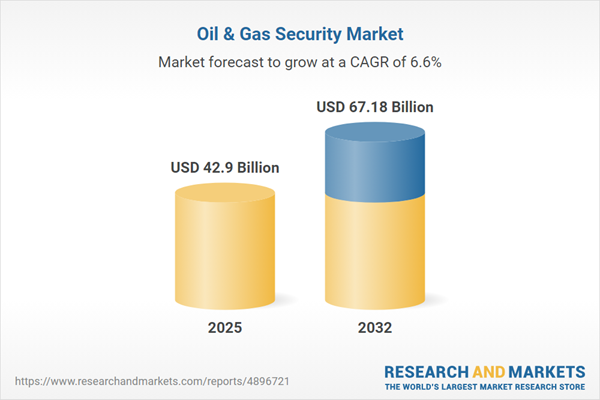Speak directly to the analyst to clarify any post sales queries you may have.
The oil and gas security market is undergoing rapid transformation as executive stakeholders respond to complex risks and shifting regulatory standards. Senior leaders now prioritize integrated strategies, blending physical and cybersecurity to maintain compliance and safeguard critical infrastructure.
Market Snapshot: Oil and Gas Security Market Size and Growth
The global oil and gas security market is estimated at USD 40.24 billion in 2024, with an expected increase to USD 42.90 billion by 2025 and projected growth reaching USD 67.18 billion by 2032. This reflects a compound annual growth rate (CAGR) of 6.61%, as organizations strengthen their security posture in response to escalating digitization, intensifying regulatory frameworks, and ongoing threats to operational resilience. Investments in advanced digital and physical security tools continue to rise, as the sector makes a concerted effort to reduce vulnerabilities, future-proof operations, and maintain uninterrupted service delivery.
Scope & Segmentation: Oil and Gas Security Market
Robust market segmentation offers actionable insights for decision-makers aiming to manage risk across diverse assets and locations. Each segment is critical for aligning technology investments with regional and operational demands while supporting compliance.
- Security Types: Integrated digital and physical security solutions, including SCADA system protection and sophisticated identity management, address modern threat vectors and enable layered defenses.
- Component Categories: Advanced surveillance, biometric authentication, analytics-focused compliance mechanisms, and intelligent sensors support early detection and swift mitigation.
- Deployment Models: Cloud, on-premises, and hybrid architectures are offered, giving organizations flexibility and scalability to address evolving operational and compliance scenarios.
- Geographical Coverage: The market encompasses the Americas, Europe, Asia-Pacific, and Middle East & Africa, accommodating distinct regulatory conditions and technology adoption levels in each region.
- Key Players: Leading firms such as Honeywell International Inc., ABB Ltd., Schneider Electric SE, Siemens AG, Cisco Systems, IBM, Palo Alto Networks, Fortinet, Check Point Software Technologies, and Trend Micro provide expertise in asset protection, incident surveillance, centralized management, and analytics integration.
Key Takeaways for Senior Decision-Makers
- Integration of IT and operational security creates a unified risk management approach, enhancing resilience against diverse and sophisticated threats.
- Cross-functional collaboration—spanning compliance, operations, and technology functions—drives effective regulatory responsiveness and comprehensive risk mitigation strategies.
- Adoption of zero-trust security frameworks strengthens identity controls and limits unauthorized access within high-value operational environments.
- Scalable and adaptable security architectures allow organizations to respond to changing regulatory demands and variations in operating conditions worldwide.
- Region-specific security policies support regulatory accuracy, enabling organizations to meet compliance requirements and thrive within unique legal and technical ecosystems.
- Centralized asset monitoring improves response readiness, supporting coordinated action that preserves business continuity during incidents.
Tariff Impact: Navigating U.S. Regulatory Changes
Forthcoming U.S. tariffs set for 2025 are driving strategic shifts in procurement and security planning for oil and gas stakeholders. There is increased attention on sourcing from local suppliers and deploying modular security systems that reinforce supply chain agility. Achieving cost-efficient integration between cloud and on-premises security platforms has become fundamental, helping organizations adjust to evolving compliance requirements and market conditions.
Methodology & Data Sources
This report’s findings are built on primary interviews with subject matter experts, operations executives, and security technology professionals, cross-referenced with independent market research and the latest industrial data. The combination ensures that analysis reflects the latest developments in threats, regulations, and technological adaptation across oil and gas operations.
Why This Oil and Gas Security Market Report Matters
- Empowers organizations to pinpoint risk areas, prioritize compliance measures, and build resilience in challenging operational environments through actionable insights.
- Supports strategic investment and adaptive security planning, addressing ongoing threats and rapid regulatory change while staying ahead of technological advances.
- Provides benchmarking for security maturity, helping decision-makers monitor progress against industry standards and organizational targets.
Conclusion
This report gives senior leaders a comprehensive roadmap to develop adaptive security frameworks, effectively meet industry challenges, and maintain secure, compliant operations as the oil and gas security landscape evolves.
Additional Product Information:
- Purchase of this report includes 1 year online access with quarterly updates.
- This report can be updated on request. Please contact our Customer Experience team using the Ask a Question widget on our website.
Table of Contents
3. Executive Summary
4. Market Overview
7. Cumulative Impact of Artificial Intelligence 2025
Companies Mentioned
The companies profiled in this Oil & Gas Security market report include:- Honeywell International Inc.
- ABB Ltd.
- Schneider Electric SE
- Siemens AG
- Cisco Systems, Inc.
- International Business Machines Corporation
- Palo Alto Networks, Inc.
- Fortinet, Inc.
- Check Point Software Technologies Ltd.
- Trend Micro Incorporated
Table Information
| Report Attribute | Details |
|---|---|
| No. of Pages | 184 |
| Published | October 2025 |
| Forecast Period | 2025 - 2032 |
| Estimated Market Value ( USD | $ 42.9 Billion |
| Forecasted Market Value ( USD | $ 67.18 Billion |
| Compound Annual Growth Rate | 6.6% |
| Regions Covered | Global |
| No. of Companies Mentioned | 11 |









